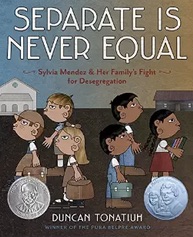Separate Is Never Equal: Sylvia Mendez and Her Family’s Fight for Desegregation
Reviewed by James Foritano
May 1, 2015
 By Duncan Tonatiuh. Harry N. Abrams, 2014. 40 pages. $18.95/hardcover or eBook. Recommended for ages 6 and up.
By Duncan Tonatiuh. Harry N. Abrams, 2014. 40 pages. $18.95/hardcover or eBook. Recommended for ages 6 and up.
Buy on FJ Amazon Store
In the summer of 1944, the Mendez family move from the city of Santa Ana, Calif., to a farm in the nearby town of Westminster. After years as a farm laborer, Gonzalez Mendez intends to be his own boss. All is well until Sylvia and her two brothers are driven to the local elementary school by their Aunt Soledad only to be told by the secretary that they must attend the local Mexican school because “Rules are rules.” Since the Mexican school is separate and very unequal to the school for white children, Aunt Soledad is upset, Sylvia is sad, and her father, Gonzalez, who is a businessman and “used to dealing with people,” decides to ask why.
Sylvia, her brothers, and their schoolmates are as much in evidence in this struggle as are Sylvia’s resolute parents. A growing legion of parents and institutions join them in questioning the local chain of command, and they finally file a lawsuit against the segregated school system of Orange County, Calif. When their struggle stalls due to the inertia of prejudice, Sylvia and her brothers are pictured resolutely eating their lunches in the bare schoolyard of their assigned school, really a shack by an odorous cow pasture. But despite their muted colors and restrained lines, these child-like forms have a bounce and a rhythm that speaks of hopes surviving a temporary resignation.
Likewise when this resolute family faces refusal in their campaign for allies, they stand grounded and tall while the other family that has petitioned unsuccessfully recedes to a shrunken, anxious distance. But look at the children, as young readers will, and we will see that, though their feet creep after their parents, their heads are literally turned around to face the ultimately winning side.
A glossary of terms, a bibliography, and multiple websites couched at the book’s end give due respect to this epic battle won seven years before the 1954 landmark case Brown v. Board of Education. Questions of unmet needs will always remain since inequality is a dragon with many heads, but as children emerge into greater social consciousness, this well-documented story will enable them to explore deeply the structures of freedom and their maintenance. Just as importantly, the illustrations are informed not only by adult wit, but also by a child’s ability to feel the delight and sadness, expectation and disappointment often hidden from adult eyes. And isn’t that where it all starts?



Comments on Friendsjournal.org may be used in the Forum of the print magazine and may be edited for length and clarity.